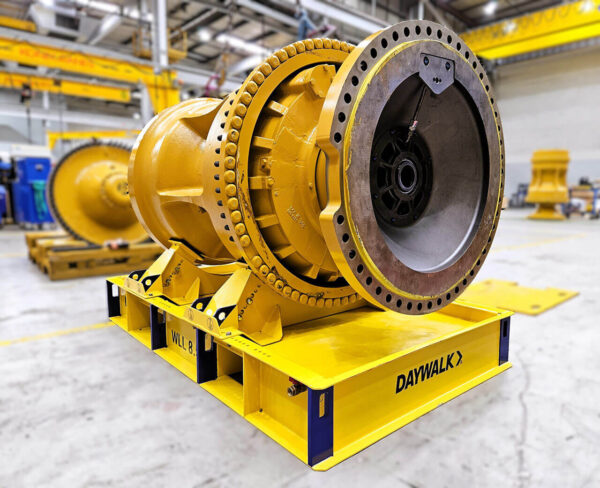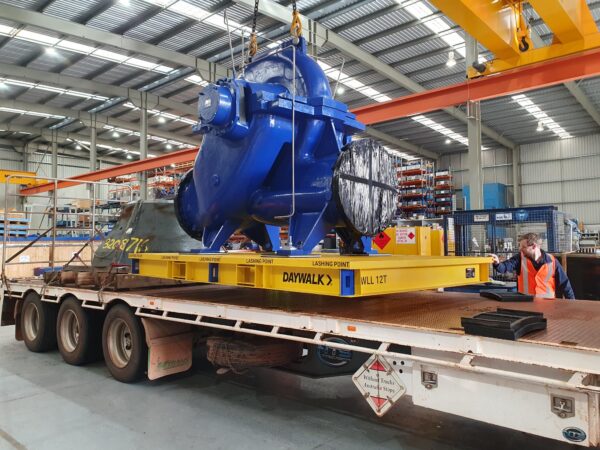Being a warehouse supervisor sometimes means fielding the same questions repeatedly. Some of these questions will fall under the category of STRAPPING AND RESTRAINTS, as they’re part of daily warehouse processes.
Here are some of the most common questions asked about strapping and restraints – answered for your convenience. Feel free to print this out for personal or communal reference.
We took some time to interview an Daywalk product specialist, Gary, who has worked in the heavy industry for years, advising on best practice in storage.
Question: What is the correct way to strap equipment?
Response: There is no one correct way to strap equipment, so don’t hesitate to take some time to figure out how to start strapping based on what needs to be strapped. It’s important, however, to remember that straps should only be threaded under the top boards that have product weighing down on the boards, so that the strapping doesn’t loosen the boards.
Question: Which type of strapping is approved by safety standards?
Response: Strapping will typically come with a supplier’s test result. However, if you require further testing, you can engage a NATA testing laboratory to verify stated ratings. It’s when you start using lifting slings, lashings, or transport ratchet straps that you’ll be required initial and ongoing inspection/testing/certification, depending on application.
Question: Is there an Australian Standard for strapping of goods in storage and in transport?
Response: There is no Australian Standard. However, there is the Load Restraint Guide, published by NTC, which provides comprehensive guidance and Best Practice.
Question: What is the load rating of strapping?
Response: There is a huge spectrum of load ratings in the full range of strapping, some indication of which is as follows:
- PP (polypropylene): hand grade 100kg to 150kg; heavy band 250kg to 400kg
- PET: 700kg to 900kg
- Polywoven: 19mm 600kg to 1100kg; 31mm 2300kg
- Composite: 1000kg to 2000kg
- Steel: 700kg to 900kg
Question: Does everything stored on pallets have to be strapped down?
Response: This depends on your warehouse policies and procedures. In some warehouses, all goods must be either strapped to the pallet or retained in a cage, timber collar/s with retainer clips, or pallet carton. Certain sites give the option of strapping, stretch film, or heat shrink.
It is absolutely critical to set up strict housekeeping rules and abide by said rules, particularly when goods are stored at heights.
Question: Do we strap gear or do we use stretch film instead?
Response: This also depends on the site policies and procedures that are standard for your type of operation. Bear in mind that some packaging policies stipulate primary and secondary restraint. Sometimes, this can be met by two straps followed by heat shrink plastic applied to the pallet, or pallet-wrapping the pallet.
Question: How do I cut steel strapping safely?
Response: Daywalk has a safety cutter that has rubber-brakes on the jaws to slow down the kick-back from the cut steel strap.
Question: Some of our steel strapping has stretched over time; is there any strapping that is better at holding tight and not stretching?
Response: PET has what is called memory – if any elongation occurs, the composition of the PET works constantly to “pull back” the strap to its original length.
Question: Once steel strapping gets cut, it flings out and is so dangerous; what is the solution to the dangers of steel strap?
Response: There is no exact solution to the dangers presented by steel strap other than to stop using it; many sites have banned or at least discouraged the utilisation of steel strap on site and moved to alternative materials, such as PET, polywoven (woven polyester), or composite strapping.
Depending on the demand in your warehouse, the polywoven, composite, or PET strap can all be good alternatives to steel strapping.
If there is high demand or throughput in your warehouse, the PET strapping system (either battery-powered or pneumatic), is a suitable option as these tools are fast, helps reduce operator fatigue, and minimises repetitive actions/fatigue caused by ratchet tools.
Question: Is there a safer alternative to steel strap?
Response: Yes, there is. Consider PET for higher throughput operations; for heavy equipment applications, consider polywoven or composite.
Question: What is the most time efficient strapping? Or, what is the fastest strapping system?
Response: As a rough rule of thumb, PET (technical name of Polyethylene terephthalate) – otherwise known as polyester strapping – is the fastest strapping system, when using a battery strapper, or a pneumatic strapper.
Question: What is the most cost-effective durable strap?
Response: This is a broad question, as it depends on what the application is. As a broad strokes answer, PET is viewed as a strong and cost-effective strap.
Question: What is the best strapping if I am exporting products?
Response: This is a balancing challenge: you need the strapping to be strong and fit for its purpose, while at the same time being cost-efficient as you will never see the strap again. It would be practical to choose a one-time use strap such as PET. At times, however, ratchet straps are required to lash product down securely in the shipping container.
Question: What strapping uses cheap tools? Some of the battery-powered strapping tools are too expensive for us as our volume is too low to warrant a big investment in tooling.
Response: Hand tools will always be substantially cheaper compared to battery-powered or pneumatic tools. Even within hand tools, there are different countries of origin, and there is a significant price spectrum.
Question: Who can give us a comparison between the price per metre of the different types of strap?
Response: Daywalk can give some indications for your reference, as set out below:
- Steel strapping is often sold by the kilogram and a number of metres is not necessarily shown; as a rough rule of thumb you can use the following indicative metres/kg numbers:
- 12mmx0.4mm:
- 16mmx0.5mm:
- 19mmx0.56mm:
- Polywoven strapping will usually have the metres per roll stated:
- Polywoven and steel strapping will have a similar price per metre, so while it will not save you a lot of money in the purchase price, it will potentially save you huge amounts from a safety perspective
- PET strapping will usually have the metres per roll stated:
- PET is commonly more cost effective than steel strap; it is not unusual that the price per metre will be half the price of steel strapping
Question: I am tired of cutting straps and having to start again – is there a re-usable strapping system that we can use in our warehouse?
Response: Yes, there are re-usable strapping systems for warehouse storage, which are as follows:
- Hook and Loop Straps (often known by a popular brand Velcro):
- Easy to use
- Fast to loosen and tighten (once the initial threading is done)
- Re-usable
- Only designed for lightweight goods
- CamLock Straps
- Easy to use
- Fast to loosen and tighten (once the initial threading is done)
- Reusable multiple times – the CamLock system is superior to hook and loop, in that the CamLock strap and buckle are not likely to be clogged up by dust and dirt
- Can be used on multiple weight consignments
- Colour-coded to specify different lengths
Question: How many widths of strapping are there?
Response: Ther are a number of widths of strap; the three most common widths of strap are 12mm, 16mm, and 19mm. In addition, there is also 9mm as well as 25mm, 32mm, and 50mm.
Question: What is the correct width of strap to use in my warehouse?
Response: If you have been using 16mm steel strap, use 16 mm PET; if you have been using 19mm steel strap, use 19mm PET or 19mm Polywoven strapping.
Question: Why are there different colour straps? Do the different colours mean anything?
Response: On standard warehouse straps (such as PET, composite, and polywoven strapping), colour is simply used as branding. However, with lashing or lifting straps, colour indicates specific industry strengths.
Question: Is strapping UV stabilised? How long does it last in the weather?
Response: Polywoven strapping has good UV stability; if the strap has bright colour pigment, the pigment will fade. Pigment fading is inconsequential, however, as the strap will retain its integrity despite losing colour. For example, when polywoven is used for tying down a tarpaulin in the weather, you can come back months later and find that the knots can be undone without being cut, as the strap has not deteriorated. PET is also good in the weather; the strapping will keep its integrity and memory even after long periods of time. Steel strap will last through the weather, but it tends to rust and therefore lose tension.
Question: How do I know what buckle or seal to use? I have seen plastic and metal and heavy-duty metal; is there a guide to the joining of the straps?
Response: From a speed point of view, a seal-less joint is the first choice. Plastic buckles are only suitable for light gauge applications and for hand tightening; even with hand tightening a plastic buckle can break under human tensioning. Metals buckles are good to use, especially for hand grade polypropylene and polywoven strapping. If the strap is too stiff, a buckle can be difficult to thread the strap through; in this case, a crimp seal is a better option.
Question: What is the price for CamLocks?
Response: There are 3 lengths in the 50mm wide CamLock strap, which are as follows:
- 3m
- 5m
- 7m
Question: What is the price for Ratchet Straps?
Response: There are multiple lengths and strength ratings. Pricing indication is as follows:
- 6m / 1T
- 9m / 2.5T





